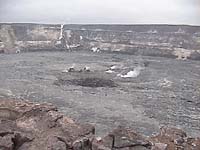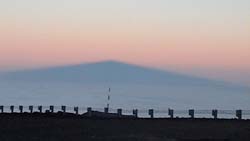

Registration starts this evening. I got here a little early. Flying 6+ hours from Seattle always knocks me out for at least a day. I have always found that I can deal with the sessions if I give myself a few days to acclimate. So I went sightseeing.
The Big Island is one of the unique areas in the world. Some parts of the island get over 200 inches of rain a year. In fact a storm in November dropped 20-30 inches in 24 hours, washing out one of the major roads around the island. Other areas get only inches a year. The conference is located in one of these.
Other parts are temperate, subtropical and tropical. Someone said that there are 17 different climate zones in the world and the Big Island has 15. I'd believe it. The starkness of the black lava flows and the green lushness of the rain forest are real contrasts.
I drove down to the Volcano National Park, passing the University of Hawaii at Hilo (Hum, note to self. Any sabbatical possibilities??). The National Park is very spooky, with an overcast sky and the smell of sulfur in the air. Yet, there is vigorous greenery all around. Kilauea has been erupting continuously since the early '80s. It has added a lot of new acreage to the island.
 You can walk right into the volcanic caldera of Kilauea, with steam pouring out of vents and yellow sulfur residue on the ground. This picture is looking directly into the center of the caldera. Not too many years ago, this was a pool of lava several hundred feet thick. It has since cooled down but is still a dangerous area to climb around in. I was amazed at the actions of some people who view this as some sort of Disneyland ride. They walked right out onto the lip, with crumbling rock and fissures under their feet. I expected to find some of their bodies at the bottom of the 100 foot cliff
You can walk right into the volcanic caldera of Kilauea, with steam pouring out of vents and yellow sulfur residue on the ground. This picture is looking directly into the center of the caldera. Not too many years ago, this was a pool of lava several hundred feet thick. It has since cooled down but is still a dangerous area to climb around in. I was amazed at the actions of some people who view this as some sort of Disneyland ride. They walked right out onto the lip, with crumbling rock and fissures under their feet. I expected to find some of their bodies at the bottom of the 100 foot cliff
I continued down the Chain of Craters road, stopping to walk through a lava tube formed in the '50s. It is because of a similar tube today that there is no standing lava in the caldera. The lava flows out of the mountain in a superhighway to the sea. Or at least it has been. Today, the lava is pooling in a region about 2 kilometers from the sea.
 Old lava covers the road at sea level, preventing any further advance. From the distance of a few kilometers, you can see the lava flowing very slowly down the hillside.
Old lava covers the road at sea level, preventing any further advance. From the distance of a few kilometers, you can see the lava flowing very slowly down the hillside.
This is a series of pictures taken as the sun set. You can see the flares as trees are set on fire by lava. The upper edge of the lava has crusted over but every so often it breaks out and you can see the red, molten rock below. The last picture was taken with the night vision feature of my digital camcorder. Yep, these new fangled devices not only can shoot in very little light but they can also image by infrared, and work like night vision goggles. This photo really shows the areas of light and heat given off by the volcano.
Again, people viewed this as some sort of event put on by the National Park Service. The area I took these pictures from is a few hundred yards into the lava flow. This is very sharp, very treacherous stuff. It is pitch black. In the nighttime, it is be virtually impossible to traverse very far. Yet I saw families with toddlers walking much further in towards the active flow with only a small flashlight to guide them back. The poor rangers kept telling people about the dangers but they can not stop people from being stupid.
One reason it is so dark is the almost universal lack of normal street lights on the island. About all you will find is some yellow "Fog" lights. This is because this island is home to one of the most amazing features on the earth, Mauna Kea.
This mountain is 13,796 feet above sea level, but, as I was constantly told, you have to count its height from the sea floor. Since Mauna Kea was (is) a shield volcano, it rose from the ocean bed. Thus, it is the highest mountain on Earth, at over 35,000 feet.
What makes it amazing in my book is that you can drive to the top of it. There is no where else in the world that you can reach such a height just by driving. The reason there are few bright lights on this island is that Mauna Kea is home to over 15 observatories. They keep the island dark to keep light pollution to a minimum.
I took a tour up to the top of Mauna Kea, to watch the sun set and for an evening of sky gazing. We drove on a "saddleback" between Mauna Kea and the other large volcano on the island, Mauna Loa. We had to stop at the visitors center at 9000 feet for about 45 minutes to acclimate ourselves. Going from sea level to 9000 feet causes some major changes in the body's metabolism. If you are not careful, there is a real chance of serious bodily damage such as pulmonary embolism. Too quick an ascent and your body can be really hurt.
We then continued up a very rutted road that required 4 wheel drive. Sheer cliffs fell away from us and I was glad I was not driving. I just looked at the scenery and hoped for the best. There was no snow on the top of the mountain but the driver said they usually get 24-36 inches a year. There are a few ski clubs that bomb down the slopes when snow is present. The temperature at the top was pretty balmy, about 42 °F, although it can dip below 0 °F. There are some storms headed this way so I may get a chance to see snow on the peak before I leave. A lot of the terrain is actually the result of glaciers that reached over 200 feet thick during one of the last ice ages.
Mauna Kea is above 40% of the atmosphere and 80% of the water vapor. So the sky is really clear up at the top, with even the twinkle of stars muted. We got to watch the sun set and it was incredible. The panorama below ranges from the summit of Mauna Kea on the left through Mauna Loa to Mt. Haleakula on Maui (between the last 2 observatories) on the right.

 The picture to the left is the shadow of Mauna Kea to the east as the sun sets to the west. The cloud bank was at about 6000 feet and extended out to the horizon. After the sun set we drove back down to 9000 feet to look at some stars. The guides had two 8 inch Celestrons to set up and show us the heavens. Even with a barely waxing moon, it was pretty bright. Because of the near-equatorial location of Hawaii, you can see something like 80% of the northern sky and most of the southern also.
The picture to the left is the shadow of Mauna Kea to the east as the sun sets to the west. The cloud bank was at about 6000 feet and extended out to the horizon. After the sun set we drove back down to 9000 feet to look at some stars. The guides had two 8 inch Celestrons to set up and show us the heavens. Even with a barely waxing moon, it was pretty bright. Because of the near-equatorial location of Hawaii, you can see something like 80% of the northern sky and most of the southern also.
We started out with a near-transit of the moon by the International Space Station. Very cool. It just bombed out of the northwestern sky and crossed above us in just a few seconds. Here is a Quicktime movie of it.
I saw Jupiter and the Galilean moons, and Saturn with its rings. The dog star, Sirius, the brightest star in the heavens, just stood out. In fact, it was hard to find many of the normal stars because there were so many visible. It was amazing.
Okay, okay. Enough tourist stuff. I have gone and registered for the meeting. I have my hardcover book of the papers, over 600 pages, along with the standard softbound one containing the abstracts. Looks like there will be some really interesting talks this time, spanning "traditional" bioinformatics (if there is such a thing) to bioethics. But tomorrow is taken up with something unique to this meeting, tutorials. Yes, they spend a day providing 'beginning' tutorials on the subjects that will be covered in the meetings, allowing us to have a reasonable chance of understanding some of the talks. So, there are tutorials on data analysis for microarrays, high performance technical computing and information extraction from scientific texts. I am looking forward to the last one because there are some scientific texts that I am sure have no information. This last one goes from 7-10 PM so it may be a late update tomorrow.
Well, I am off to read the proceedings, or at least glance through them. Kind of like cramming for a final but with not quite so much on the line. Since a lot of the presentations follow pretty much what is in the papers, it makes it easier to take notes if you know what is new. Tomorrow, I'll scope out the tutorials and try to locate the best seat for the meetings.